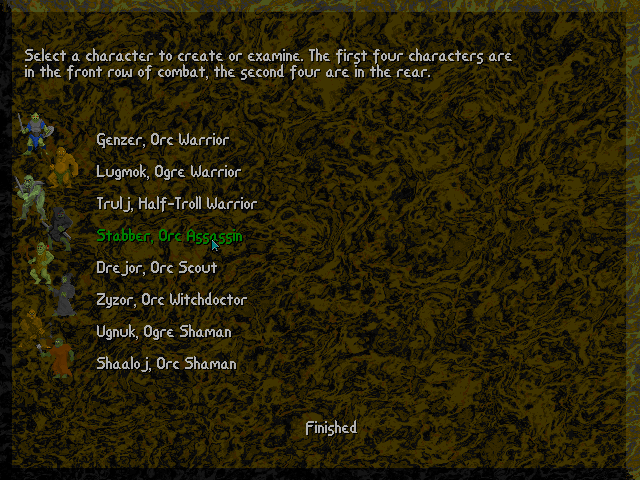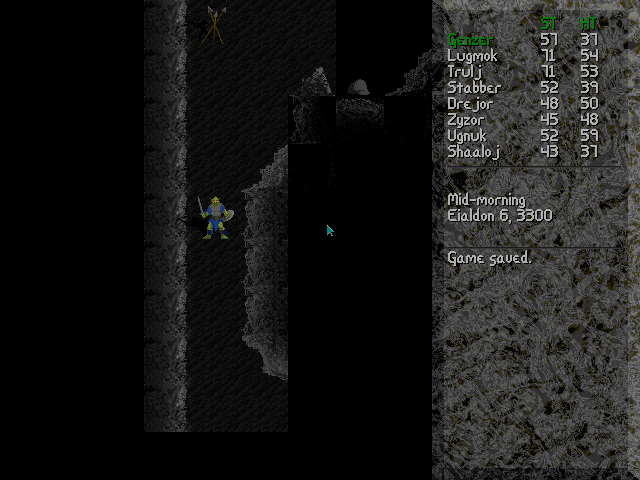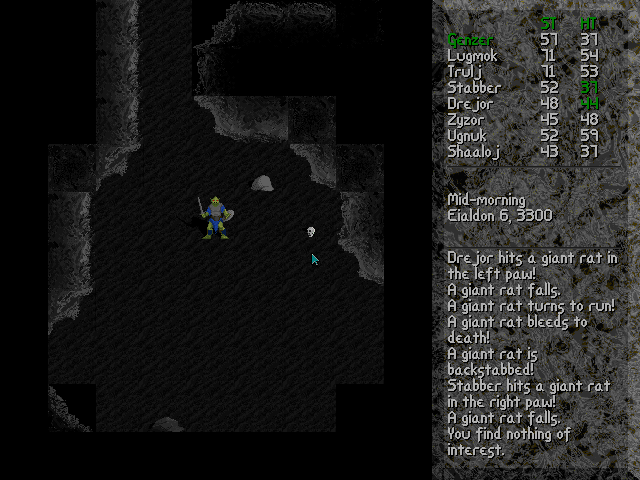Retro Replay Review
Gameplay
Natuk delivers a deeply tactical, party-based experience that will appeal most to players who revel in meticulous character development and detailed combat mechanics. Every battle in Natuk feels consequential thanks to its percentile-based system, which determines success and failure with a granular focus on specific body-part damage rather than abstract hit points. From the opening skirmish against giant rats to the climactic showdown with Emperor Molvosh, players must constantly weigh the risks of every swing, parry, and spell.
(HEY YOU!! We hope you enjoy! We try not to run ads. So basically, this is a very expensive hobby running this site. Please consider joining us for updates, forums, and more. Network w/ us to make some cash or friends while retro gaming, and you can win some free retro games for posting. Okay, carry on 👍)
Character progression in Natuk departs from the traditional level-up model, opting instead for a skill-point allocation system reminiscent of Rolemaster. As your orcs, ogres, and half-trolls earn experience, they gain points that can be spent immediately on any skill or attribute. This flexibility encourages experimentation: a hulking half-troll warrior might dabble in witchdoctor chants, while an agile assassin can develop rudimentary healing magic. The costs to improve skills rise as they become more advanced, forcing players to choose between breadth and depth.
Movement on the overworld unfolds in real time and is intermittently interrupted by random encounters—some friendly, many hostile. Successfully interacting with wandering traders or avoiding orcish bandits adds a layer of unpredictability and excitement to exploration. Once you enter a town or dungeon, the view shifts to a side-on perspective, and tactical combat seamlessly begins on the same map, preserving immersion and minimizing menu-juggling. Seasoned players will appreciate the “quick combat” option for those inevitable grind sessions, though many will relish manually resolving fights to exploit parries, feints, and targeted strikes.
The magic system is especially noteworthy: spells are constructed from syllables, inviting creative experimentation. Discovering that “Rakhimxa” hurls small stones, then appending “Gokh” to create a shock projectile, feels like uncovering arcane lore rather than simply selecting from a menu. Because spellcasting drains strength instead of using mana pools, spellcasters must think carefully about when—and on whom—to unleash their powers.
Natuk’s combat pace and complexity can be daunting at first, but mastering its nuances is immensely satisfying. Every decision—from how you distribute skill points to which body part you aim for—carries weight. For those seeking a hardcore RPG with strategic depth and minimal hand-holding, Natuk’s gameplay remains a compelling journey.
Graphics
Visually, Natuk embraces the aesthetic of late-80s and early-90s PC RPGs, offering simple yet functional 2D art that prioritizes clarity over flash. Environments are rendered in a top-down style on the world map and shift to a side-view when adventuring in towns or dungeons. While modern gamers may find the sprite work rudimentary, each location and enemy type is distinct enough to read at a glance—an important consideration in tight combat situations.
The sprite animations are minimal but serviceable. Characters walk, attack, and cast spells with a handful of frames, conveying the essentials without distracting from gameplay. Enemy designs range from oversized rats to twisted cultists, each bearing an orcish flavor that reinforces the game’s narrative perspective. Though the backgrounds are static and somewhat repetitive, the tile sets evoke a consistent atmosphere of frontier outposts, dank caverns, and war-scarred battlefields.
User interface elements feel dated but functional: windows for inventory, character sheets, and combat menus rely on basic icons and text lists. All information needed for tactical decision-making—initiative order, remaining movement points, and body-part hit probabilities—is presented clearly, even if the layout lacks modern polish. Players who grew up on later point-and-click RPGs may miss tooltips and drag-and-drop convenience, but those accustomed to classic shareware titles will find nothing jarring.
Overall, Natuk’s graphics serve its hardcore RPG ambitions well. They never distract from the deep systems at play, and the straightforward art style ensures that tactical details remain front and center. For fans of retro role-playing visuals, Natuk’s faithful homage to classics like Wizard’s Crown and Ultima will feel right at home.
Story
Natuk’s narrative thrust centers on revenge, casting players as a motley crew of eight orcs, ogres, and half-trolls on a mission to punish the cruel Emperor Molvosh. The opening premise is darkly humorous: a failed assassination attempt leads to the gruesome execution of family members and the bureaucratic reassignment of the survivors to a remote military outpost. This blend of tragic stakes and orcish gallows humor sets the tone for the entire adventure.
From the frontier outpost, your party embarks on an expansive quest, traversing wilderness, infiltrating orcish towns, and plundering caverns in search of clues and power. Encounters with orcish patrols, wandering merchants, and rival adventuring parties flesh out the world and reinforce the sense of living in an orc-run society. Dialogue is minimal but effective, relying on terse exchanges and environmental storytelling to convey the brutality and camaraderie of orcish life.
Though Natuk lacks cinematic cutscenes, its story unfolds organically through exploration and combat. Every town square, temple ruin, and hidden crypt contributes to the overarching narrative, rewarding thorough investigation with lore snippets and side quests. The eventual confrontation with Molvosh feels earned, as you peel back layers of his tyranny and grow stronger alongside your mismatched comrades.
Character interactions within your party further enrich the tale. Rivalries flare up during long battles, and the occasional “bar fight” in an orcish tavern reveals colorful backstories. These moments of levity underscore the dark revenge plot and remind you that, despite their fearsome appearances, your orcs are individuals driven by pride, loyalty, and a thirst for vengeance.
Overall Experience
Natuk stands as a testament to old-school RPG design, offering unparalleled depth at the cost of a steep learning curve. The game’s complexity—percentile skills, targeted body-part combat, syllable-based magic—can be intimidating, but it also provides a sense of mastery once you grasp the systems. For players seeking a crunchy, no-nonsense role-playing challenge, few titles deliver satisfaction like Natuk.
Exploration feels rewarding, with randomized encounters and branching choices weaving a tapestry of orcish culture and frontier peril. Combat remains the game’s centerpiece, and the ability to resolve tough battles via quick-combat mode keeps the pacing brisk when necessary. Meanwhile, the flexible skill system encourages replayability: no two parties need be the same, and experimenting with unconventional character builds is both possible and often advantageous.
Visually and narratively, Natuk may feel primitive compared to contemporary RPGs, but these “shortcomings” are deliberate design choices that foreground substance over style. The game’s shareware heritage is evident in its modular structure and retro flair, yet the depth of its mechanics rivals that of pricier, fully produced titles.
Ultimately, Natuk is a niche classic for hardcore role-playing enthusiasts. If you savor intricate combat tables, flexible character progression, and a defiantly “orcish” revenge saga, this freeware gem deserves a spot in your library. Casual RPG fans, however, may find its uncompromising difficulty and dated interface challenging. Approach Natuk with patience and a strategic mindset, and you’ll discover a richly rewarding adventure that stands the test of time.
 Retro Replay Retro Replay gaming reviews, news, emulation, geek stuff and more!
Retro Replay Retro Replay gaming reviews, news, emulation, geek stuff and more!








Reviews
There are no reviews yet.